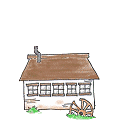https://permies.com/t/43317/natural-building/Bathroom-Remodel-Retrofitting-Natural-Materials
This is the thread I made way back when I was trying to actually have a bathroom in my house in the middle of a cold February. I believe I touch on several aspects of mixing and applying lime plaster though m picture-taking was limited... Bill Bradbury is
the man when it comes to plaster knowledge (and loads of other stuff, read any and all of his commentary throughout the site). He's really committed to finding a way to make walls breathe well, even in conjunction with our modern materials. I believe he is suffering from a bad internet connection at the moment given a fire he recently at his place in Utah but hopefully he will show up in time to congratulate you on a job well done.
I mixed my lime putty with a high-powered corded drill and a paddle mixer. I let that slake for a week or so before mixing it into sand in a large tub with a hoe. 3:1 lime putty to sand ratio BUT, I would say make a couple of test swatches on the wall, with a little more or a little less sand, and with a little more or a little less water. When it's right, you'll really know. I did not make more than one or two trials and felt pretty unsure when I finally started doing it. My mix was too thick and chunky, I was pushing a ton of it straight through the lath. But by the end of the first coat I had added a bit more putty and a bit more water and was getting a really nice buttery, creamy spread, smoothing it out over the wall.
I used two limes, both Type-S hydrated. Basically powered lime is super chemically unstable and is dying to bond with water, so they mix it with a bit of water to form hydrated lime that is slightly more stable, but still able to bond further on its way to reverting to limestone. It's pretty interesting actually and not totally dissimilar to drywall, which is essentially gypsum that has been mixed with just enough water to form a rigid crystalline structure. Hence drywall and lime's fire retardent natures. They have water bound up in them so they actually can't exceed 212 degrees until all of their water is boiled off.
I'd be really curious to see pictures of your progress. I'm terrible at posting my own, and usually even my finished pictures still have tools and trash taking up half the frame but I sure like looking at other people's. How did you affix the wattle panels to the timbers? What style of frame did you build? I'm kind of curious to see how self-builders are putting stuff together naturally on a budget (though maybe you're not on a budget). Condensation-wise I can't imagine you'll have any problems whatsoever, that thing is gonna breathe beautifully, and with the plaster it's definitely not gonna be drafty as long as your flashing and utility stuff is good. I have no idea where you're located, but no insulation around here in Michigan would be killer. I'd be burning a cord a month through the winter. If you do find over time that you're disappointed by the performance, you could obviously always increase the thickness of your walls. And if you didn't want to lose interior space you could look into installing a wall truss of some sort. I'm actually trying to figure out how to build this raised porch on the north side of my house at the moment so that I can beef up my northern wall by a good foot and a half. I haven't decided whether it will be clay-woodchips or straw bales, but I'll keep the forum abreast if and when I manage to get going on that.
Right now I'm digging some drainage trenches to carry runoff to my crater garden in preparation for the eventual extended roof overhang, so I'll get back to it. Gotta finish before I harvest this evening.
Best,
Kieran









 Really? Not one person on Permies has any idea about applying lime plaster? Im shocked…….and disappointed….
Really? Not one person on Permies has any idea about applying lime plaster? Im shocked…….and disappointed…. 1
1



































